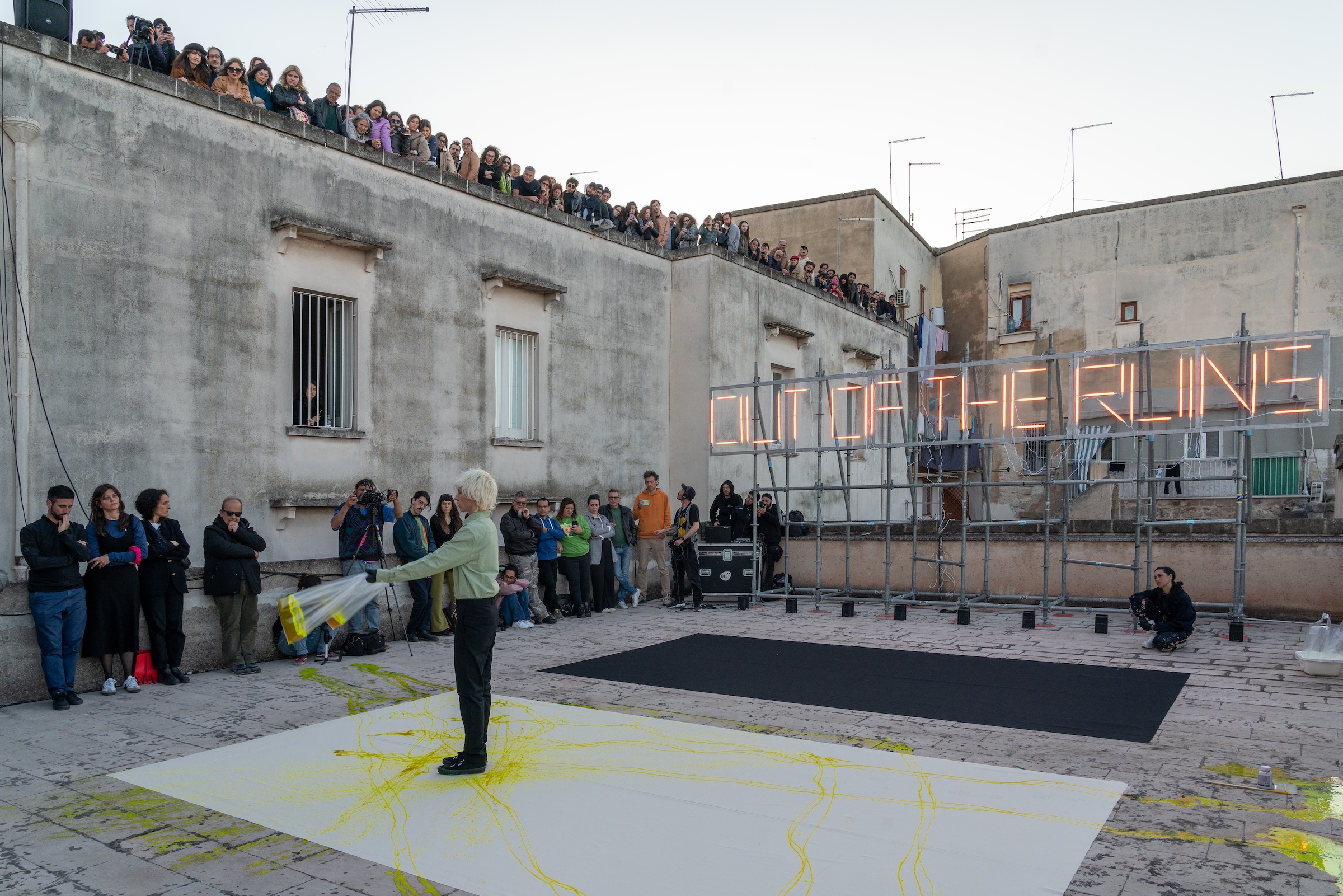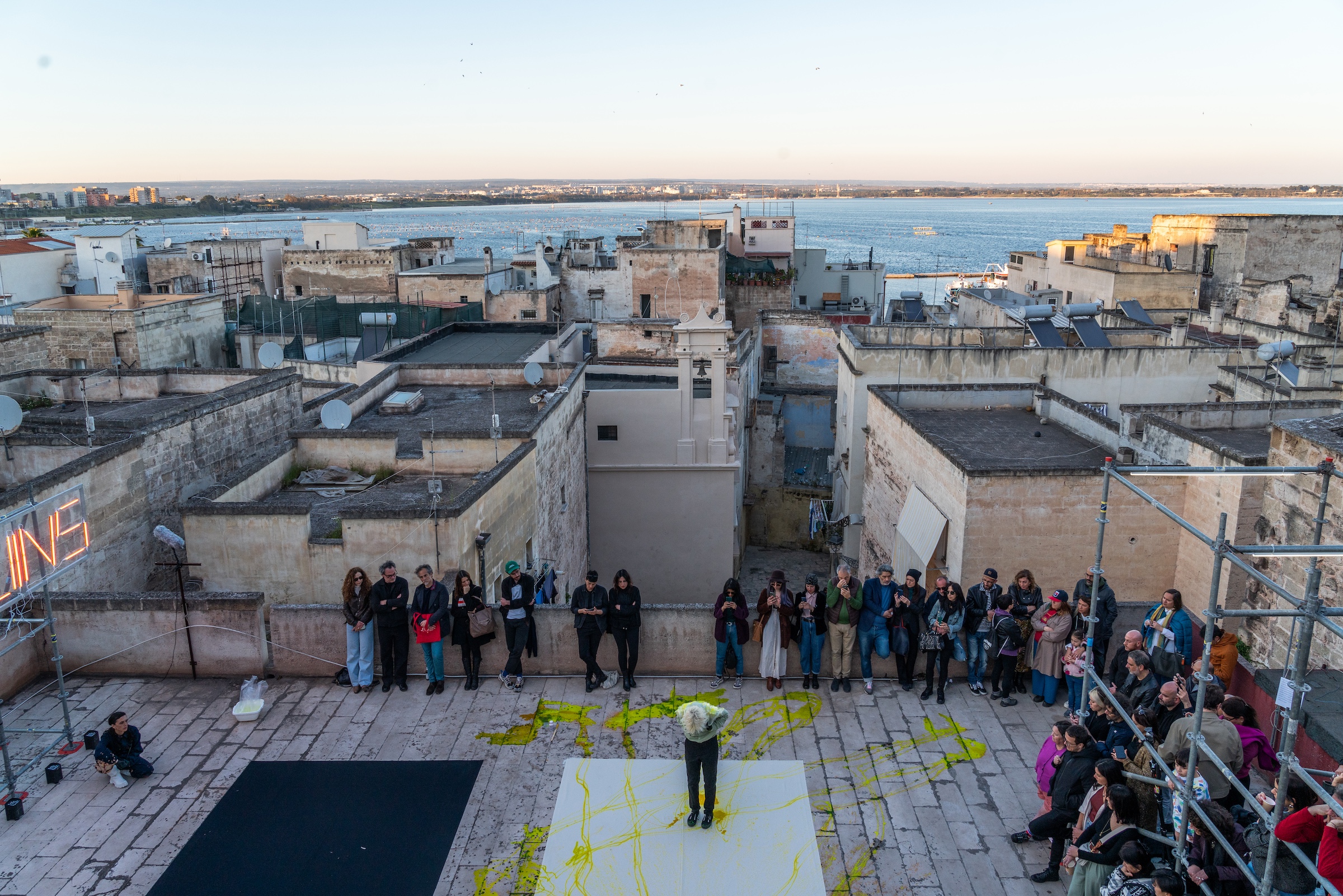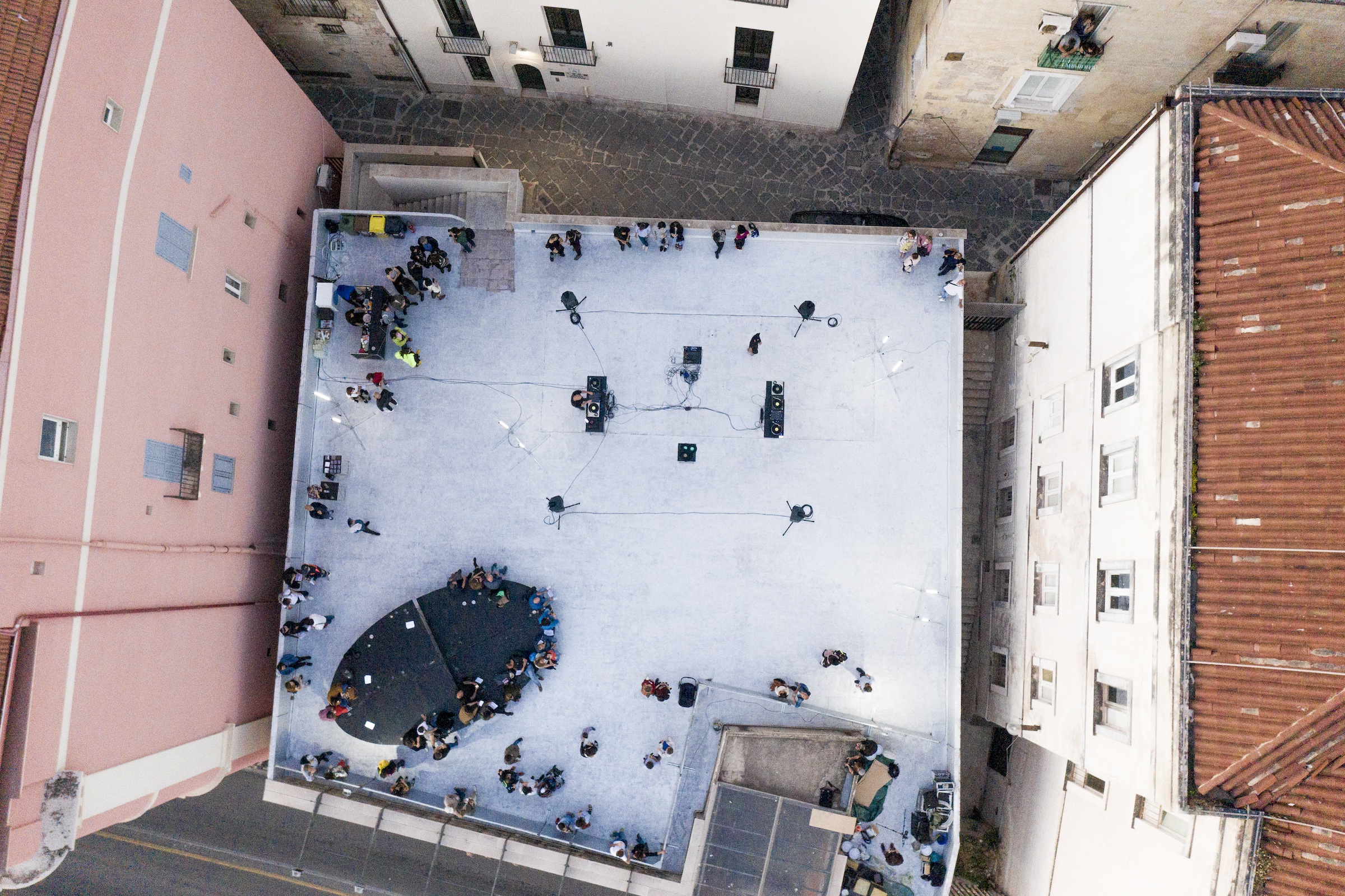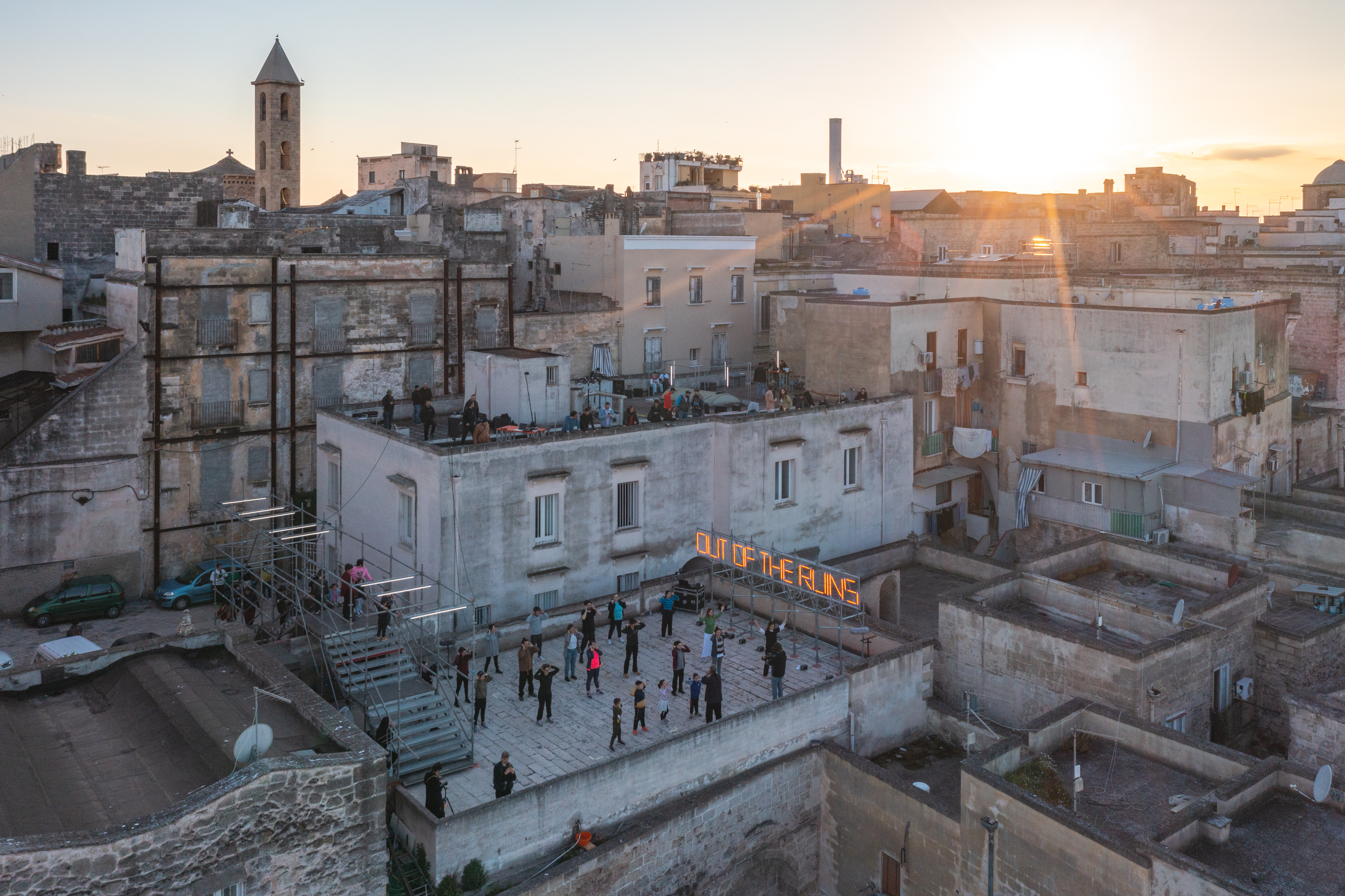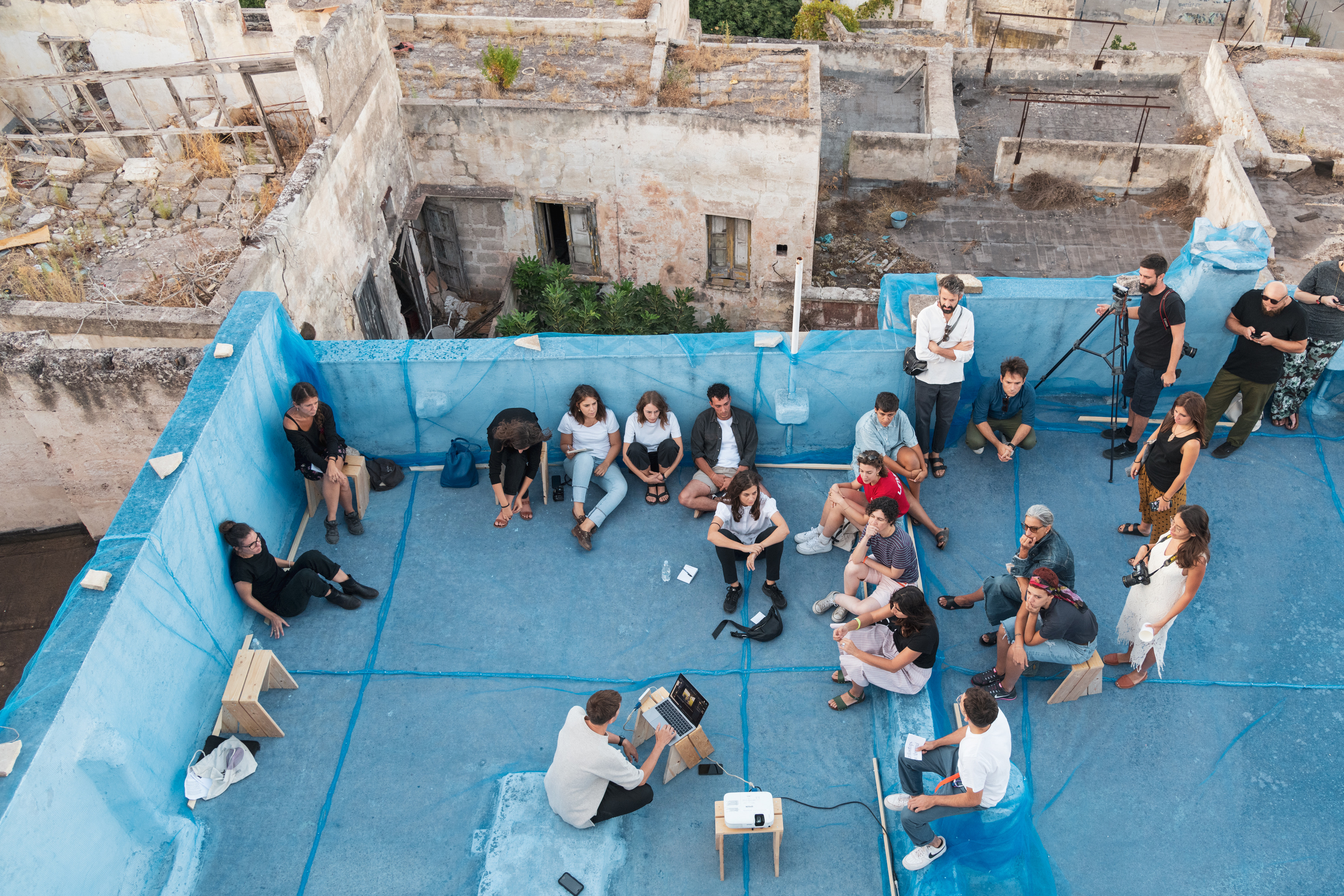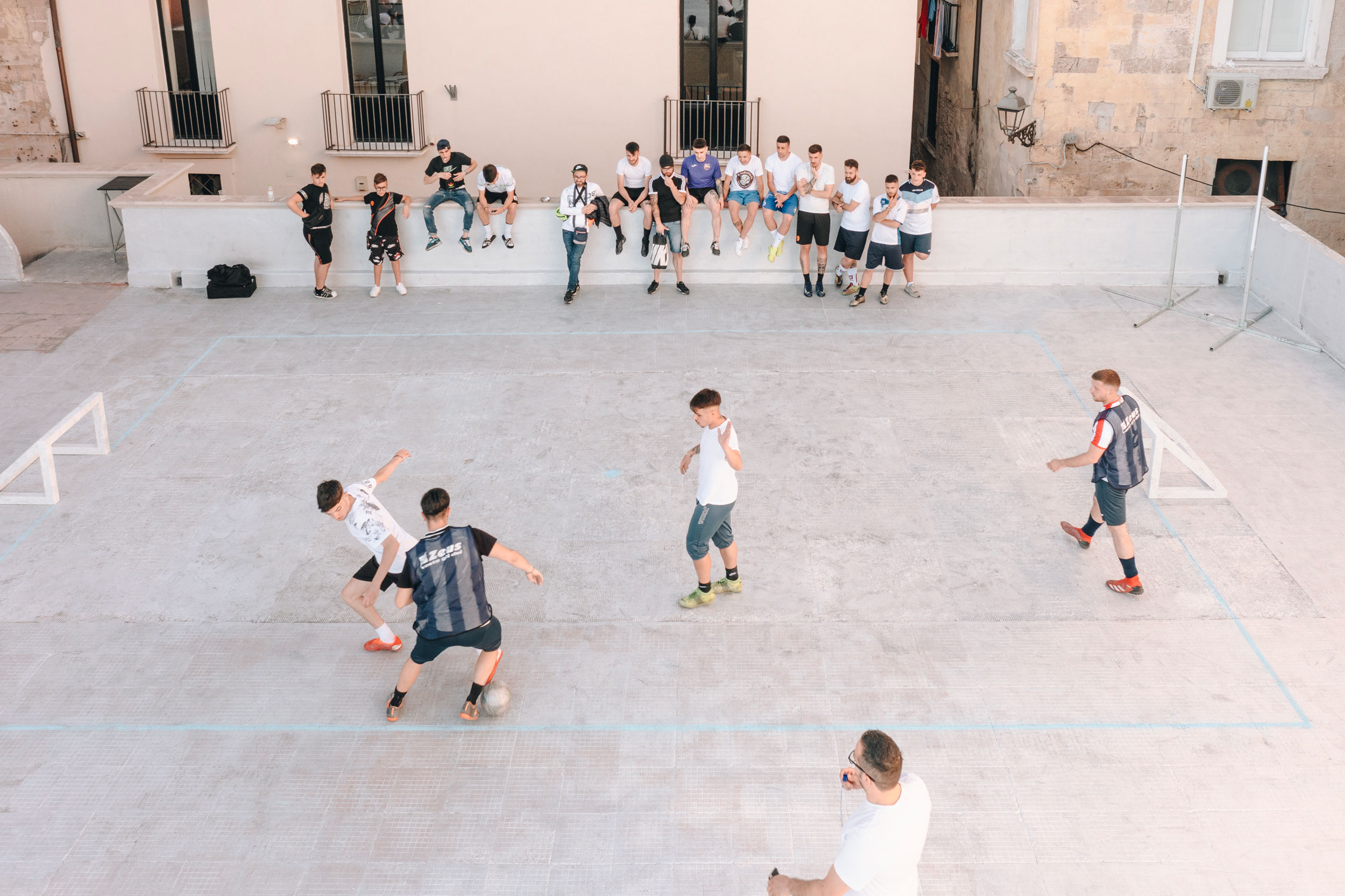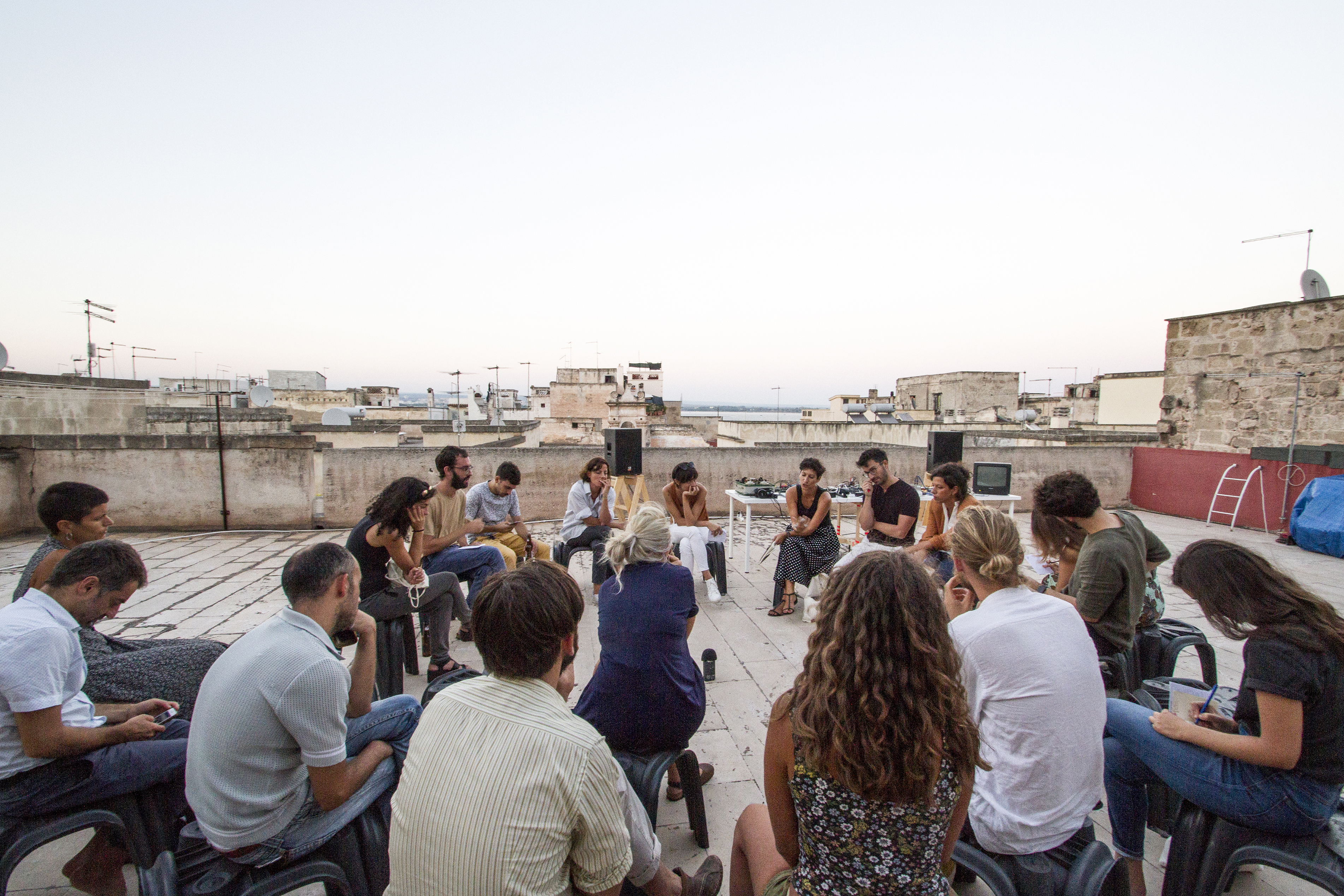Prioritising the places and people that need it the most
Post Disaster Rooftops
Post Disaster Rooftops
Since 2018, Post Disaster has been developing the Rooftops project, inviting people to view the city from a different perspective and identifying the rooftops as symbolic places of Taranto, from which it is possible to conduct an immediate survey of the disaster: the collapsed buildings, the voids left by abandoned activities, the skyline of the industrial plants. The dense network of rooftops is interpreted as a new system of public spaces, investigating the social role of architecture and desi
Italy
Local
Taranto
Mainly urban
It refers to other types of transformations (soft investment)
Yes
2023-04-22
Yes
I-Portunus Houses Scheme, 2021
Yes
Culture Moves Europe Second Call Individual Mobility Action, 2023
No
As a representative of an organisation
Since 2018, Post Disaster has developed the Rooftops project, now an established festival that redefines urban perspectives by recognizing rooftops as symbolic spaces in Taranto. These vantage points offer a direct view of the city's disaster: collapsed buildings, abandoned sites, and the imposing industrial skyline.
Inaugurated in 1964, Taranto’s steel plant—Europe’s largest—has secured Italy's role in steel production while severely impacting public health and violating human rights. In 2022, a UN report listed Taranto among the world’s “sacrifice zones” due to extreme environmental pollution. As a symbol of failed Western policies, the city serves as an ideal setting for Post Disaster’s mission: fostering new local development strategies through art, community engagement, and environmental awareness.
Post Disaster Rooftops aims to reshape Taranto’s narrative by positioning art and culture as pillars of urban revitalization. The project fosters inclusive artistic and research-driven practices to counteract social segregation and enhance livability. Its core objective is to create temporary public spaces for social integration, uniting local creatives, international artists, and residents of diverse backgrounds.
Recognized for its impact, Rooftops received the Sustainable Art Prize (2021) and was selected by the Italian Ministry of Culture for urban regeneration initiatives (2022). In 2023, it was featured at the Venice Biennale as one of Italy’s nine most innovative architectural practices, followed by invitations to the Malta Art Biennale (2024) and appointed as one of the nine national Festival Architettura funded by the Ministry of Culture (2025). Additionally, the project secured the Culture Moves Europe grant and won the Moleskine Foundation’s Creative Pioneers Award.
Inaugurated in 1964, Taranto’s steel plant—Europe’s largest—has secured Italy's role in steel production while severely impacting public health and violating human rights. In 2022, a UN report listed Taranto among the world’s “sacrifice zones” due to extreme environmental pollution. As a symbol of failed Western policies, the city serves as an ideal setting for Post Disaster’s mission: fostering new local development strategies through art, community engagement, and environmental awareness.
Post Disaster Rooftops aims to reshape Taranto’s narrative by positioning art and culture as pillars of urban revitalization. The project fosters inclusive artistic and research-driven practices to counteract social segregation and enhance livability. Its core objective is to create temporary public spaces for social integration, uniting local creatives, international artists, and residents of diverse backgrounds.
Recognized for its impact, Rooftops received the Sustainable Art Prize (2021) and was selected by the Italian Ministry of Culture for urban regeneration initiatives (2022). In 2023, it was featured at the Venice Biennale as one of Italy’s nine most innovative architectural practices, followed by invitations to the Malta Art Biennale (2024) and appointed as one of the nine national Festival Architettura funded by the Ministry of Culture (2025). Additionally, the project secured the Culture Moves Europe grant and won the Moleskine Foundation’s Creative Pioneers Award.
rooftops as unusual public spaces
culture-based urban regeneration
urban and social practice
art as catalyst of change
learning from disasters
As a culture-based regeneration initiative, the Post Disaster Rooftops festival operates within the existing infrastructure of Città Vecchia’s rooftops. This dense network of rooftops is reinterpreted as a system of interconnected public spaces, establishing a vertical relationship with the streets below.
Città Vecchia, a historically working-class neighborhood, has been increasingly depopulated since the 1960s due to building collapses and economic decline. Its identity—shaped by its physical condition as an island, separated from both the modern city and the industrial area—remains closely tied to informal networks and systems of mutual aid.
Our approach aims to achieve sustainability across multiple dimensions. From a social sustainability perspective, the festival seeks to activate micro-economies by involving local residents, many of whom rely on informal or precarious sources of income. By fostering social inclusion and encouraging behavioral shifts, the project strives to mitigate the disruptive impact of one-time cultural events and contribute to long-term community development.
With regard to environmental sustainability, our interventions prioritize resource efficiency and minimal ecological impact. The festival employs cost-effective construction strategies, repurposing open-source metallic tubular systems from partner cultural events and renting scaffolding from local suppliers. Additionally, materials and services are sourced from local firms whenever possible to reduce transportation-related environmental impact.
Città Vecchia, a historically working-class neighborhood, has been increasingly depopulated since the 1960s due to building collapses and economic decline. Its identity—shaped by its physical condition as an island, separated from both the modern city and the industrial area—remains closely tied to informal networks and systems of mutual aid.
Our approach aims to achieve sustainability across multiple dimensions. From a social sustainability perspective, the festival seeks to activate micro-economies by involving local residents, many of whom rely on informal or precarious sources of income. By fostering social inclusion and encouraging behavioral shifts, the project strives to mitigate the disruptive impact of one-time cultural events and contribute to long-term community development.
With regard to environmental sustainability, our interventions prioritize resource efficiency and minimal ecological impact. The festival employs cost-effective construction strategies, repurposing open-source metallic tubular systems from partner cultural events and renting scaffolding from local suppliers. Additionally, materials and services are sourced from local firms whenever possible to reduce transportation-related environmental impact.
Rooftops activates new public spaces through performative actions and temporary structures, fostering a collective experience of the city and reshaping perceptions of Città Vecchia and Taranto’s broader cultural heritage.
The project offers an immersive, collective aesthetic experience, guiding participants through Città Vecchia and reinforcing its recognition as a Common Good. For many citizens—particularly older generations—this historic district has long been perceived as an inaccessible or neglected area.
Through its initiatives, Rooftops seeks to revive forgotten or overlooked aspects of the urban landscape, unveiling untold narratives and highlighting exemplary practices from both past and present. By shifting perspectives and generating positive storytelling, the project aims to reframe the city’s identity and heritage.
Many of the selected locations are publicly owned buildings that were restored in the 1980s as part of the Piano Blandino, a regeneration plan for the Old Town. Despite receiving acclaim as an award-winning urban planning project in 1968, the plan was never fully realized, and many of its renovated structures have remained unused or abandoned for extended periods. Rooftops seeks to bring renewed attention to these spaces, acknowledging their historical significance and potential for contemporary urban regeneration.
Over a span of seven years, Rooftops has revitalized a total of 20 locations and public spaces within Città Vecchia. These include both publicly and privately owned rooftops and courtyards, as well as main streets, alleys, small squares, waterfronts, playgrounds, cultural venues, and a museum.
The project offers an immersive, collective aesthetic experience, guiding participants through Città Vecchia and reinforcing its recognition as a Common Good. For many citizens—particularly older generations—this historic district has long been perceived as an inaccessible or neglected area.
Through its initiatives, Rooftops seeks to revive forgotten or overlooked aspects of the urban landscape, unveiling untold narratives and highlighting exemplary practices from both past and present. By shifting perspectives and generating positive storytelling, the project aims to reframe the city’s identity and heritage.
Many of the selected locations are publicly owned buildings that were restored in the 1980s as part of the Piano Blandino, a regeneration plan for the Old Town. Despite receiving acclaim as an award-winning urban planning project in 1968, the plan was never fully realized, and many of its renovated structures have remained unused or abandoned for extended periods. Rooftops seeks to bring renewed attention to these spaces, acknowledging their historical significance and potential for contemporary urban regeneration.
Over a span of seven years, Rooftops has revitalized a total of 20 locations and public spaces within Città Vecchia. These include both publicly and privately owned rooftops and courtyards, as well as main streets, alleys, small squares, waterfronts, playgrounds, cultural venues, and a museum.
Post Disaster’s Rooftops Festival is a creative initiative rooted in Taranto’s cultural landscape, highlighting the benefits of diversity and cross-disciplinary exchange.
The festival aims to make culture more accessible and affordable, lowering barriers to participation. By offering free access to internationally renowned contemporary artworks, it enriches the local cultural scene and engages audiences from various backgrounds and age groups.
ROOFTOPS invites participants to experience the city from a new perspective. This participatory and generative approach brings people together to discover unfamiliar buildings and share the experience with an unexpected community of residents, citizens, artists, and travelers. Through this renewed sense of reciprocity, a conscious community emerges, recognizing its collective presence as a catalyst for transformative action.
Using rooftops reclaims underutilized spaces, returning them as cultural assets to the local community while addressing the shortage of cultural venues and safe spaces for dialogue between different communities.
The project also identifies and supports emerging local talent, involving them in the production process. Over the years, it has become a key platform for young people seeking to start or advance careers in the arts and cultural and creative industries (ICC) or gain deeper insights into cultural production.
By offering fresh perspectives and opportunities, Rooftops Festival aims to foster local artistic growth and counteract the high rate of youth leaving the city.
The festival aims to make culture more accessible and affordable, lowering barriers to participation. By offering free access to internationally renowned contemporary artworks, it enriches the local cultural scene and engages audiences from various backgrounds and age groups.
ROOFTOPS invites participants to experience the city from a new perspective. This participatory and generative approach brings people together to discover unfamiliar buildings and share the experience with an unexpected community of residents, citizens, artists, and travelers. Through this renewed sense of reciprocity, a conscious community emerges, recognizing its collective presence as a catalyst for transformative action.
Using rooftops reclaims underutilized spaces, returning them as cultural assets to the local community while addressing the shortage of cultural venues and safe spaces for dialogue between different communities.
The project also identifies and supports emerging local talent, involving them in the production process. Over the years, it has become a key platform for young people seeking to start or advance careers in the arts and cultural and creative industries (ICC) or gain deeper insights into cultural production.
By offering fresh perspectives and opportunities, Rooftops Festival aims to foster local artistic growth and counteract the high rate of youth leaving the city.
All actions led by Post Disaster are designed and implemented to generate a positive social impact, which includes the following key objectives:
1. Social Infrastructure Development – Revitalizing the social, economic, and cultural fabric of Taranto, with a particular focus on the Città Vecchia district. To achieve this, Post Disaster has established long-term partnerships with organizations that share a social mission within the same context. For instance, Symbolums ETS, a social organization based in Città Vecchia, is dedicated to promoting workforce inclusion for socially disadvantaged groups. In the context of Rooftops, Symbolums ETS acts as a social and cultural mediator, facilitating co-creation processes between local communities and artists during artistic productions, while also supporting maintenance and care of event locations. Another key partner is CREST Cooperative, a theatre company that provides essential production and logistical support for the implementation of artistic activities.
2. Enhancement of Existing Historical Heritage – Contributing to the regeneration of the local community and encouraging the repopulation of the Città Vecchia island. The Rooftops Festival benefits from the patronage of the Municipality of Taranto, which actively supports the project by offering temporary partnerships that grant access to buildings and venues for festival activities.
These initiatives benefit local citizens both directly, by offering them opportunities to participate as audiences in cultural events, and indirectly, as they experience the broader economic, social, and cultural returns generated by these activities within the territory.
1. Social Infrastructure Development – Revitalizing the social, economic, and cultural fabric of Taranto, with a particular focus on the Città Vecchia district. To achieve this, Post Disaster has established long-term partnerships with organizations that share a social mission within the same context. For instance, Symbolums ETS, a social organization based in Città Vecchia, is dedicated to promoting workforce inclusion for socially disadvantaged groups. In the context of Rooftops, Symbolums ETS acts as a social and cultural mediator, facilitating co-creation processes between local communities and artists during artistic productions, while also supporting maintenance and care of event locations. Another key partner is CREST Cooperative, a theatre company that provides essential production and logistical support for the implementation of artistic activities.
2. Enhancement of Existing Historical Heritage – Contributing to the regeneration of the local community and encouraging the repopulation of the Città Vecchia island. The Rooftops Festival benefits from the patronage of the Municipality of Taranto, which actively supports the project by offering temporary partnerships that grant access to buildings and venues for festival activities.
These initiatives benefit local citizens both directly, by offering them opportunities to participate as audiences in cultural events, and indirectly, as they experience the broader economic, social, and cultural returns generated by these activities within the territory.
One of the primary objectives of the Rooftops project is to connect Taranto with national and international creative networks by engaging artists, researchers, academics, and informal groups from diverse contexts. The initiative aims to bridge gaps in knowledge production and circulation within the framework of North-South cooperation at the European level.
Locally, stakeholders play a vital role by providing financial, communicative, relational, productive, and logistical support, as well as offering venues. These stakeholders include businesses and private companies that supply services before, during, and after the event; cultural and educational institutions that engage specific communities; and non-profit organizations that facilitate cultural mediation and community involvement.
On a national scale, Rooftops has received continuous support and sponsorship from the Matera-Basilicata 2019 Foundation, with a technical partnership with Open Design School, which has enabled the reuse of setups developed during the European Capital of Culture (ECoC) program.
Internationally, Rooftops has established networks with researchers, academics, and artists from leading cultural institutions, universities, and non-profit organizations across Europe. Key collaborators include Istituto Svizzero, UdK Berlin, London Metropolitan University, and the Royal College of Arts London, positioning Rooftops as a platform for cross-border cooperation and local research.
Locally, stakeholders play a vital role by providing financial, communicative, relational, productive, and logistical support, as well as offering venues. These stakeholders include businesses and private companies that supply services before, during, and after the event; cultural and educational institutions that engage specific communities; and non-profit organizations that facilitate cultural mediation and community involvement.
On a national scale, Rooftops has received continuous support and sponsorship from the Matera-Basilicata 2019 Foundation, with a technical partnership with Open Design School, which has enabled the reuse of setups developed during the European Capital of Culture (ECoC) program.
Internationally, Rooftops has established networks with researchers, academics, and artists from leading cultural institutions, universities, and non-profit organizations across Europe. Key collaborators include Istituto Svizzero, UdK Berlin, London Metropolitan University, and the Royal College of Arts London, positioning Rooftops as a platform for cross-border cooperation and local research.
Post Disaster Rooftops is a multidisciplinary initiative dedicated to decentralizing knowledge production, operating at the intersection of various creative and artistic disciplines, including architecture, urban placemaking, social design, cultural production, performing arts, contemporary arts, graphic design, and communication.
The Post Disaster team comprises four spatial and cultural practitioners—two architects and two designers—who oversee all project phases, from curation and production to final delivery. Their work is complemented by collaborations with external professionals and experts, expanding the project’s capacity for knowledge building when needed.
The festival’s format is designed to foster dialogue and knowledge exchange by engaging both academic and non-academic partners through its public programs. Central to this approach are assemblies—open forums that function as spatial and performative platforms for discussion, learning, and public engagement. These gatherings encourage interaction among scholars, professionals, and the general public, creating an inclusive environment for critical discourse.
The insights and outcomes generated through these discussions are systematically documented and preserved in a publicly accessible digital archive, ensuring long-term accessibility and knowledge dissemination.
The Post Disaster team comprises four spatial and cultural practitioners—two architects and two designers—who oversee all project phases, from curation and production to final delivery. Their work is complemented by collaborations with external professionals and experts, expanding the project’s capacity for knowledge building when needed.
The festival’s format is designed to foster dialogue and knowledge exchange by engaging both academic and non-academic partners through its public programs. Central to this approach are assemblies—open forums that function as spatial and performative platforms for discussion, learning, and public engagement. These gatherings encourage interaction among scholars, professionals, and the general public, creating an inclusive environment for critical discourse.
The insights and outcomes generated through these discussions are systematically documented and preserved in a publicly accessible digital archive, ensuring long-term accessibility and knowledge dissemination.
Post Disaster Rooftops can be considered an example of relational urbanism practice, it reimagines the city as an interconnected ecosystem where spaces are active interfaces fostering interaction and mutual enrichment.
Rooftops proposes a collective performance that involves the unconventional use of urban spaces, i.e. the rooftops, establishing a platform for dialogue, exchange, and horizontal learning. The initiative pursues a dual objective: to decentralize the production of critical thought and to explore the social value of design and architecture in marginal areas.
In the specific context of Taranto, the Città Vecchia transforms into an open-air stage, where buildings and streets become an integral part of the artwork, fostering innovative forms of cultural engagement that transcend the traditional divide between the audience and the artwork itself.
This project experiments with innovative practices in creating enabling processes for the design, use, and management of an abandoned public space. Through a structured program of artistic and cultural events, it facilitates exchanges where the outcome largely depends on the ability to foster empathy—namely, the interactions that emerge between artists, designers, residents, and spectators.
The final result boosts places’ attractiveness while fostering the interaction between residents and temporary communities, as well as increasing cross-cultural and intergenerational exchanges within the activated spaces.
Rooftops proposes a collective performance that involves the unconventional use of urban spaces, i.e. the rooftops, establishing a platform for dialogue, exchange, and horizontal learning. The initiative pursues a dual objective: to decentralize the production of critical thought and to explore the social value of design and architecture in marginal areas.
In the specific context of Taranto, the Città Vecchia transforms into an open-air stage, where buildings and streets become an integral part of the artwork, fostering innovative forms of cultural engagement that transcend the traditional divide between the audience and the artwork itself.
This project experiments with innovative practices in creating enabling processes for the design, use, and management of an abandoned public space. Through a structured program of artistic and cultural events, it facilitates exchanges where the outcome largely depends on the ability to foster empathy—namely, the interactions that emerge between artists, designers, residents, and spectators.
The final result boosts places’ attractiveness while fostering the interaction between residents and temporary communities, as well as increasing cross-cultural and intergenerational exchanges within the activated spaces.
Our approach is founded on three key pillars:
1. Urban Heritage Recovery – The project identifies underutilized urban spaces and activates them as public venues. Rooftops are reimagined as temporary public spaces, offering an alternative perspective on ongoing urban transformations. This approach not only enhances cultural accessibility but also addresses the shortage of safe spaces for interaction among diverse communities. Existing architectural structures, often precarious, become integral to the project, functioning as arenas for public debates, backdrops, and stages that transcend the traditional boundary between spectators and works of art.
2. Direct Participation and Co-Creation – The community is actively engaged in the creation of site-specific performances, urban explorations, and public assemblies. This participatory process fosters a sense of belonging, stimulates dialogue, and cultivates collective awareness regarding the transformation of urban spaces.
3. Interdisciplinary Exchange – The project invites artists, thinkers, researchers, and practitioners to contribute their expertise, exploring new interpretations of urban space. This cross-disciplinary approach transforms rooftops into open-air stages, where the city’s historical fabric serves as a dynamic backdrop for artistic and civic engagement.
This methodology promotes urban regeneration, participation, and micro-economies through the reactivation of rooftops and local heritage. The project provides safe cultural spaces that foster exchanges between diverse communities, empowering the city to break free from negative narratives. Rooftops encourages individuals to observe the city from a new perspective, creating participatory experiences that connect residents, citizens, and artists alike.
1. Urban Heritage Recovery – The project identifies underutilized urban spaces and activates them as public venues. Rooftops are reimagined as temporary public spaces, offering an alternative perspective on ongoing urban transformations. This approach not only enhances cultural accessibility but also addresses the shortage of safe spaces for interaction among diverse communities. Existing architectural structures, often precarious, become integral to the project, functioning as arenas for public debates, backdrops, and stages that transcend the traditional boundary between spectators and works of art.
2. Direct Participation and Co-Creation – The community is actively engaged in the creation of site-specific performances, urban explorations, and public assemblies. This participatory process fosters a sense of belonging, stimulates dialogue, and cultivates collective awareness regarding the transformation of urban spaces.
3. Interdisciplinary Exchange – The project invites artists, thinkers, researchers, and practitioners to contribute their expertise, exploring new interpretations of urban space. This cross-disciplinary approach transforms rooftops into open-air stages, where the city’s historical fabric serves as a dynamic backdrop for artistic and civic engagement.
This methodology promotes urban regeneration, participation, and micro-economies through the reactivation of rooftops and local heritage. The project provides safe cultural spaces that foster exchanges between diverse communities, empowering the city to break free from negative narratives. Rooftops encourages individuals to observe the city from a new perspective, creating participatory experiences that connect residents, citizens, and artists alike.
Rooftops is designed as both a project and a process capable of generating positive artistic and social contributions. Its multidisciplinary nature and the use of unconventional locations for artistic expression make it adaptable and replicable across diverse urban and rural contexts.
The key factors supporting its replicability include:
1. Sharing Expertise and Methodology – The project’s approach has demonstrated its adaptability in various settings. For example, the commissioned artistic intervention during maltabiennale.art 2024 at Fort St. Elmo showcased the potential of transforming an abandoned venue within a national heritage site, while also providing a safe space for the underground artistic scene to gather and perform.
2. Facilitating Spatial Transformations Through Cost-Effective Interventions – The use of lightweight, modular, and standardized rented structures enables rapid design and execution processes. This approach is both affordable and practical, as standard construction and event industry elements are widely available in different locations.
3. Fostering Extra-Territorial Engagement – By building short- and long-range networks with partners in regions that share similar missions and values, the project facilitates knowledge exchange and mutual support, fostering a broader sense of collaboration and understanding.
The key factors supporting its replicability include:
1. Sharing Expertise and Methodology – The project’s approach has demonstrated its adaptability in various settings. For example, the commissioned artistic intervention during maltabiennale.art 2024 at Fort St. Elmo showcased the potential of transforming an abandoned venue within a national heritage site, while also providing a safe space for the underground artistic scene to gather and perform.
2. Facilitating Spatial Transformations Through Cost-Effective Interventions – The use of lightweight, modular, and standardized rented structures enables rapid design and execution processes. This approach is both affordable and practical, as standard construction and event industry elements are widely available in different locations.
3. Fostering Extra-Territorial Engagement – By building short- and long-range networks with partners in regions that share similar missions and values, the project facilitates knowledge exchange and mutual support, fostering a broader sense of collaboration and understanding.
The project addresses several key global challenges identified by the Sustainable Development Goals (SDG 2030), offering concrete solutions at the local level.
Reducing Inequalities (SDG 10) and Sustainable, Inclusive Cities (SDG 11) – The project operates in marginalized areas often marked by isolation and social segregation. Through art and culture, it creates new spaces for social interaction and active participation, fostering the inclusion of local communities and promoting the development of micro-economies.
Climate Action (SDG 13) and Life on Land (SDG 15) – The initiative targets areas affected by environmental pollution and urban decay, transforming open spaces into opportunities for collective use and awareness. By repurposing rooftops and underutilized urban spaces, it encourages sustainable forms of reclaiming the territory.
Culture and Innovation for Sustainable Development (SDG 4, SDG 9) – The project introduces a model of cultural and urban regeneration grounded in participatory and interdisciplinary practices. Through site-specific performances, public assemblies, and urban explorations, it promotes a renewed awareness of the territory and its potential.
Through these actions, the project provides a localized response to global challenges, demonstrating how art, culture, and participation can serve as catalysts for social and environmental transformation.
Reducing Inequalities (SDG 10) and Sustainable, Inclusive Cities (SDG 11) – The project operates in marginalized areas often marked by isolation and social segregation. Through art and culture, it creates new spaces for social interaction and active participation, fostering the inclusion of local communities and promoting the development of micro-economies.
Climate Action (SDG 13) and Life on Land (SDG 15) – The initiative targets areas affected by environmental pollution and urban decay, transforming open spaces into opportunities for collective use and awareness. By repurposing rooftops and underutilized urban spaces, it encourages sustainable forms of reclaiming the territory.
Culture and Innovation for Sustainable Development (SDG 4, SDG 9) – The project introduces a model of cultural and urban regeneration grounded in participatory and interdisciplinary practices. Through site-specific performances, public assemblies, and urban explorations, it promotes a renewed awareness of the territory and its potential.
Through these actions, the project provides a localized response to global challenges, demonstrating how art, culture, and participation can serve as catalysts for social and environmental transformation.
The impact assessment of Rooftops is grounded in the value proposition: “Art and culture are essential for the vitality of cities.” Producing culture in an original way requires extending beyond local boundaries, engaging collaborators who enhance the city’s relational and connective capital. This exchange of skills and perspectives provides new insights into Taranto’s challenges, reflecting broader global issues.
Since its inception in 2018, Post Disaster Rooftops has evolved from a self-funded initiative into a recognized platform, expanding its reach through grants and funding from local, national, and international governmental bodies and cultural institutions.
On a national scale, Rooftops has received continuous support from the Ministry of Culture for three consecutive editions through grants such as Creative Living Lab (3rd edition, 2022) and Festival Architettura (3rd edition, 2024). The project participated in the Italian Pavilion at the 18th Venice Biennale in 2023 and has benefited from sponsorship by the Matera-Basilicata 2019 Foundation, alongside a technical partnership with Open Design School, which enabled the reuse of setups developed during the European Capital of Culture (ECoC) program. Additional recognition includes the Creativity Pioneers Fund from the Moleskine Foundation in 2023 and the Special IGP Decaux Prize from Fondazione Italia Patria della Bellezza in Milan, awarded in 2022 for strategic communication and cultural branding.
At the European level, Rooftops has been supported by I-Portunus Houses, a European mobility program funded by Creative Europe and implemented by a consortium that includes the European Cultural Foundation (Amsterdam), MitOst EV (Berlin), and Kultura Nova Foundation (Zagreb), which provided backing for Rooftops EP04.
Since its inception in 2018, Post Disaster Rooftops has evolved from a self-funded initiative into a recognized platform, expanding its reach through grants and funding from local, national, and international governmental bodies and cultural institutions.
On a national scale, Rooftops has received continuous support from the Ministry of Culture for three consecutive editions through grants such as Creative Living Lab (3rd edition, 2022) and Festival Architettura (3rd edition, 2024). The project participated in the Italian Pavilion at the 18th Venice Biennale in 2023 and has benefited from sponsorship by the Matera-Basilicata 2019 Foundation, alongside a technical partnership with Open Design School, which enabled the reuse of setups developed during the European Capital of Culture (ECoC) program. Additional recognition includes the Creativity Pioneers Fund from the Moleskine Foundation in 2023 and the Special IGP Decaux Prize from Fondazione Italia Patria della Bellezza in Milan, awarded in 2022 for strategic communication and cultural branding.
At the European level, Rooftops has been supported by I-Portunus Houses, a European mobility program funded by Creative Europe and implemented by a consortium that includes the European Cultural Foundation (Amsterdam), MitOst EV (Berlin), and Kultura Nova Foundation (Zagreb), which provided backing for Rooftops EP04.

